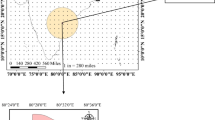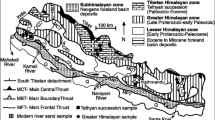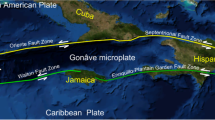Abstract
The objective of this study is to ascertain the causes of damage to buildings that occurred due to an earthquake near its source, particularly in the Pleret sub-district in Yogyakarta Special Province Indonesia. This study was conducted because a large percentage of human fatalities and structural collapse occurred during the Yogyakarta earthquake of May 27, 2006. Since the earthquake records on the site are not available, another way to obtain synthetic ground motions can be done in ways suggested by Bulajic and Manic (Motion records as a seismological input for seismic safety evaluation engineering structures, 2005), Rezaeian and Kiureghian (Earthq Eng Struct Dyn 39:1155–1180, 2010). Towards these ends, this research applied the Total Probability Theorem in the Seismic Hazard Probability Analysis (PSHA) with 3-D seismic sources. In this case, the PSHA analysis was carried out based on a 10% probability exceeded for 50 years building life time. The obtained uniform hazard spectrum (UHS) was then transferred to the risk targeted Maximum Credible Earthquake MCEr through the directivity factor Df and risk targeted factor Rf with an average increase of 8.13% to UHS. Three earthquake records were selected, and after spectral matching, the high ranging bedrock accelerations were obtained from 0.254 to 0.289 g. After conducting site response analysis, peak ground accelerations on the ground surface varied from 0.398 to 0.412 g. Furthermore, acceleration site amplifications between 1.401 and 1.426 were obtained, which are higher than the spectral site amplification between 1.215 and 1.385. Since the site amplification is still in the normal category, building damage is mostly caused by relatively high levels of ground acceleration and shaking to relatively old buildings with low material and construction quality. Although the study is still in its early stages, there are indications of fling effects on the site even though the intensity is relatively small.

















Similar content being viewed by others
Data availability
Enquiries about data availability should be directed to the authors.
References
Akram MR, Yesilyurt A, Zulfikar AC (2017) Site amplification and response analysis: a case study of October 6th 2000, M7.3 Western Tottori Earthquake Japan. In: 4th international conference on earthquake engineering and seismology, Anadolu University Turkey
Anbazhagan P, Parihar A, Rashmi HN (2012) Review of correlation between SPT-N and shear modulus: a new correlation applicable to any region. Soil Dyn Earthq Eng 36:52–69
Atkinson GM (2004) An overview of the development of seismic hazard analysis. In: 13th World conference on earthquake engineering, Vancouver, Canada, Paper No.5001
Atkinson GM (2011) An empirical perspective on uncertainty in earthquake ground motion prediction. Can J Civ Eng 38(9):1002–1015
Atkinson GM, Boore DM (2006) Earthquake ground-motion prediction equations for Eastern North America. Bulletin Seismol Soc America 96(6):2181–2205
Bajaj K, Anbazhagan P (2017) Ground motion site amplification factors for deep soil deposits sites Indo-Gangetic Bazin, PBD III, Earthquake Geotechnical Engineering, Vancouver Canada.
Baker JW (2008) An introduction probabilistic seismic hazard analysis (PSHA). Stanford University, Version 1.3, 72 p.
Bandyopadhyay S, Sengupta A, Reddy GR (2019) Development of correlation between SPT-N value and shear wave velocity and estimation of nonlinear seismic site effects for soft deposits in Kolkata city. Geomech Geoeng Int J 1–19
Bappenas (2006) Preliminary damage and loss assessment Yogyakarta and Central Java Natural Disaster, The Consultative Group on Indonesia, p 140
Bardet JP, Tobita T, NERA (2001) A computer program for nonlinear earthquake site response analysis of layered soil deposits. Department of Civil Engineering, University of Southern California, p 44
Bommer JJ, Douglas J, Scherbaum F, Cotton F, Bungum H, Fah D (2010) On the selection of ground-motion prediction equations for seismic hazard analysis. Seismol Res Lett 81(5):783–793
Boore DM (2010) Orientation-Independent, Nongeometric-Mean Measures of Seismic Intensity from Two Horizontal Components of Motion. Bull Seismol Soc Am 10(4):1830–1835
Boore DM, Atkinson GM (2007) Ground motion relations for geometric mean horizontal component of peak and spectral ground motion parameters, PEER Report, College of Engineering University of California, Berkeley, USA
Bradley BA, Baker JW (2014) Ground motion directionality in the 2010–2011 Canterbury earthquakes, Earthquake Engineering and structural Dynamics
Bulajic B, Manic M (2005) Motion records as a seismological input for seismic safety evaluation engineering structures. Conference Paper on Strong Ground Motion, Engineering Seismology, Earthquake Hazards and Risk Assessment.
Chiou BSJ, Young RR (2006) Empirical ground motion model for the average horizontal component of peak acceleration and pseudo-spectral acceleration for spectral period 0.01 t0 10 s, Interim Report for USGS Review
Cornell CA (1978) Engineering seismic risk analysis. Bull Seismol Soc Am 58(5):1583–1606
Cotton F, Scherbaum F, Bommer JJ, Bungum H (2006) Criteria for selecting and adjusting ground-motion models for specific target regions: application to central Europe and rock sites. J Seismolog 10(2):137–156
Daryono (2011), Indeks kerentanan seismik berdasarkan mikrotremor pada setiap satuan bentuk lahan di zona Graben Bantul, Daerah Istimewa Yogyakarta, Ph.D Thesis, Gadjah Mada University (in Bahasa)
Delavaud E, Cotton F, Akkar S, Scherbaum F, Danciu L, Beauval C, Drouet S, Douglas J, Basili R, Sandikkaya MA, Segou M, Faccioli E, Theodoulidis N (2012) Toward a ground-motion logic tree for probabilistic seismic hazard assessment in Europe. J Seismol 16(3):451–473
Douglas J, Faccioli E, Cotton F, Cauzzi C (2009) Selection of ground-motion prediction equations for GEM1. Earthquake, No. September, pp 1–3
Febriani F (2015) Sunsurface structure of Cimandiri fault zone, West Java Indonesia, Ph.D. Thesis, Graduate School of Science, Chiba University, p 163
Fema p-1050-1 (2015) NEHRP recommended seismic provisions for new building and other structures, p 514
Foulser-Piggott R (2014) Quantifying the epistemic uncertainty in ground motion models and prediction. Soil Dyn Earthq Eng 65:256–268
Gerami M, Abdollahzadeh D (2012) Estimation of forward directivity effects on design spectra in near field or fault. J Appl Sci Res 2(9):8670–8687
Grimaz S, Malisan P (2014) Near field domain effects and their consideration in the international and Italian seismic code. Bolletino Di Geofisica Teorica Ed Applicata 55(4):717–738
Hara A, Ohta T, Niwa M, Tanaka S, Banno T (1974) Shear modulus and shear strength of cohessive soils. Soils Foundat 14:1–12
Hasancebi N, Ulusay R (2006) Empirical correlations between shear wave velocity and penetration resistance for ground shaking assessment. Bulletin Eng Geol Environ 66:203–213
Huang YN, Whittaker AS, Luco N (2008) Maximum spectral demand in near fault region. Earthq Spectra 24(1):319–341
Imai T (1977) P and S-wave velocity of the ground in Japan, Proceeding of the 9th International Conference on Soil Mechanics and Foundation Engineering, Tokyo, Vol 2, pp 257–260
Irsyam M, Widyantoro S, Natawidjaya D.H, Meilano I, Rudyanto A, Hidayati S, Triyoso W, Hanifa N.R, Djarwadi D, Faisal L, Sunarjito (2017) Peta Sumber dan Bahaya Gempa Indonesia 2017, Pusat Studi Gempa Nasional Pusat Litbang Perimahan dan Pemukiman, p 376
Ji K, Ren Y, Wen R (2017) Site Classification for National Strong Motion Observation Network System (NSMONS) Stations in China using an empirical H/V spectral ratio method. J Asian Earth Sci 147:79–94
Kalkan E, Gulkan P (2004) Empirical attenuation equation for vertical ground motion in Turkey. Earthq Spectra 20(3):853–882
Kamai R, Abrahamson N (2015) Are near-fault fling effects captured in the new NGA West-2 ground motion model? Earthq Spectra 31(3):1629–1645
Kempton JJ, Stewart JP (2006) Prediction equation for significant duration of earthquake ground motions considering site and near source effects. Earthq Spectra 22(4):985–1013
Kukusho T, Sato K (2008) Site amplification formula for seismic zonation based on downhole array records during strong earthquakes. In: The 14th world conference on earthquake enegineering, Bei**g, China
Kumar A, Harinarayan NH, Baro O (2015) High amplification factor for low amplitude ground motion: assessment for Delhi. Disaster Adv 8(12):1–11
Kyaw ZL, Pramumijoyo S, Husein S, Fathani T, Kiyono J, Putra RR (2014) Estimation of subsurface soil layers using H/V spectrum of densely measured microtremor observations (case study: Yogyakarta City, Central Java- Indonesia). Int J Sustain Future Huma Secur 2(1):13–20
Makrup LL (2009) Pengembangan Peta Deagregasi Hazard untuk Indonesia Melalui Pembuatan Software dengan Pemodelan Sumber Gempa 3-Dimensi (3-D), Disertasi Doktor Institut Teknologi Bandung, p 235 (in Bahasa)
Maniatakis ChA, Taflampas IM, Spyrakos CC (2008) Identification of near fault earthquake record characteristics. In: The 14th world conference of earthquake Engineering, Bei**g, China
Nguyen N, Griffin J, Cipta A, Cummins PR (2015) Indonesia’s historical earthquake, geoscience, Australia, p 79
Nurwihastuti DW, Sartohadi J, Mardiatno D, Nehren U, Restu (2014) Understanding of earthquake damage pattern through geomorphological approach: a case study of 2006 earthquake in Bantul, Yogyakarta, Indonesia. World J Eng Technol 2(3):61–70
Ohta T, Hara A, Niwa M, Sakano T (1972) Elastic modulus of soil deposits estimated by N-value. In: Proceeding of the 7th Annual Conference. The Japanese Society of Soil Mechanics and Foundation Engineering, pp 265–268
Park DP, Hashash YMA (2004) Estimation of nonlinear site effects for deep soil deposits of the Mississippi Embayment, National Science Foundation Report, Mid America Earthquake Center, p 254
Partono W, Irsyam M, Wardani SPR (2017) Development of site class and site coefficient maps of Semarang, Indonesia, using field shear wave velocity data. MATEC Web Conf 101:01010
Perdhana R, Nurchahya BE (2019) Seismic microzonation base don microseismic data and damage distribution of 2006 Yogyakarta earthquake. E3S Web Conf 76:1–4
Presti DCFL, Lai CG, Puci I, ONDA (2006) Computer code for nonlinear seismic response analysis of soil deposits. J Geotech Geoenviron Eng ASCE 223–236
Rezaeian S, Kiureghian AD (2010) Simulation of synthetic ground motion for specific earthquake and site characteristics. Earthq Eng Struct Dyn 39:1155–1180
Sadigh K, Chang CY, Egan JA, Makdisi F, Young RR (1997) Attenuation relationships for shallow crustal earthquake based on California strong motion data, Seismological Reserach Letter Vol 68, Seismological Society of America
Sengara IW, Komerdevi D (2019) Site specific response analysis (SSRA) and Pairs of Ground Motions Time History Generations of a Site in Jakarta. In: The 4th international conference on earthquake engineering and disaster management, Padang Indonesia
Shiuly A, Sahu RB, Mandal S (2014) Effects of soil and ground amplification of Kalkota City. Int J Geotech Earthq Eng 5(1):1–20
Stanko D, Markusic S, Gazdek M, Sankovic C, Slukan I, Ivancic I (2019) Assessment of seismic site amplification in the City of Ivanec (NW part of Croatia) using the microtremor HVSR method and equivalent linear site response analysis. Geoscience 9(312):1–27
Stewart JP, Chiou SJ, Bray JD, Somerville PG, Abrahamson N (2001) Ground motion evaluation procedures for performance based design. Pacific Earthquake Engineering Research Center, PEER 2001, p 229
Stewart JP et al (2015) Selection of ground motion prediction equations for the global earthquake model. Earthq Spectra 31(1):19–45
Strasser F, Bommer JJ, Abrahamson N (2008) Estimating ground-motion variability: issues, insights & challenges. In: The 14th world conference on earthquake engineering
Sunardi B (2016) Percepatan Tanah sintetis kota Yogyakarta berdasarkan Deagregasi Bahaya Gempa. J Lingkungan Dan Bencana Geologi 6(2):211–218 (in Bahasa)
Widodo P (2018) The estimated of PGA map of the Mw6.4 Yogyakarta, Indonesia earthquake constructed from modified Mercalli Intensity Imm. Bull N Z Soc Earthq Eng 51(2):92–104
Widodo P (2020) Middle value ground acceleration map and site effect in the Merapi sedimentary Basin Under the 2006 Yogyakarta, Indonesia Earthquake. Nat Hazards 102:419–443
Widodo P, Makrup L, Teguh M, Suryo B, Hartantyo E (2019) Site coefficient of short Fa and long period Fv maps constructed from the probabilistic seismic hazard analysis in Yogyakarta Special Province. MATEC Web Conf 280(01001):1–17
Yahyai M, Rezayibana B, Muhammadrezapour E (2011) Effect of near fault earthquakes with forward directivity in telecommunication towers. Earthq Eng Eng Vib 10:211–218
Funding
The authors have not disclosed any funding.
Author information
Authors and Affiliations
Corresponding author
Ethics declarations
Competing interests
The authors have not disclosed any competing interests.
Additional information
Publisher's Note
Springer Nature remains neutral with regard to jurisdictional claims in published maps and institutional affiliations.
Rights and permissions
Springer Nature or its licensor holds exclusive rights to this article under a publishing agreement with the author(s) or other rightsholder(s); author self-archiving of the accepted manuscript version of this article is solely governed by the terms of such publishing agreement and applicable law.
About this article
Cite this article
Pawirodikromo, W. Ground Motions, Site Amplification and Building Damage at Near Source of the 2006 Yogyakarta, Indonesia Earthquake. Geotech Geol Eng 40, 5781–5798 (2022). https://doi.org/10.1007/s10706-022-02249-9
Received:
Accepted:
Published:
Issue Date:
DOI: https://doi.org/10.1007/s10706-022-02249-9




